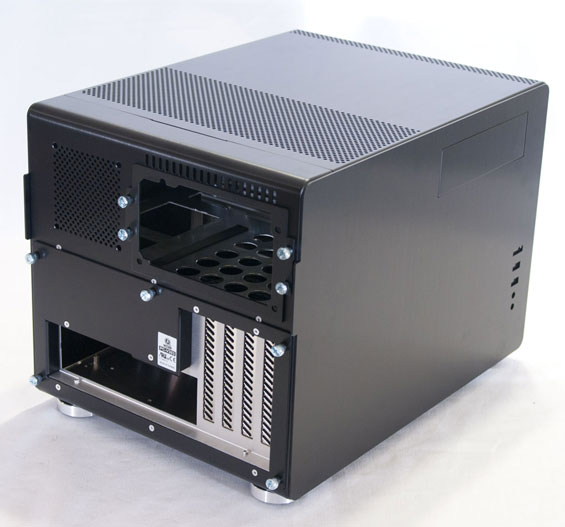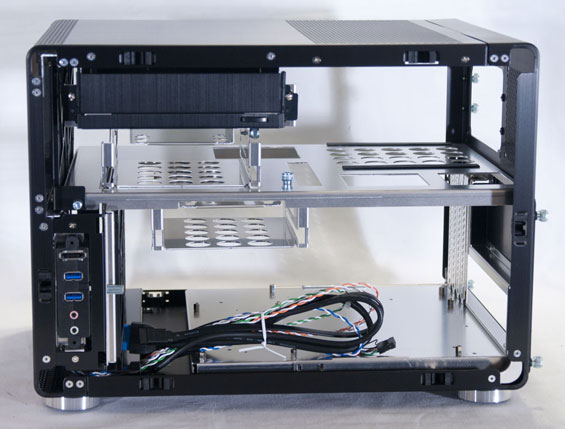Lian Li's PC-V353: Lighter Than Air
by Dustin Sklavos on September 28, 2011 4:30 AM EST- Posted in
- Cases/Cooling/PSUs
- MicroATX
- SFF
- Lian Li
- Mini-Tower
In and Around the Lian Li PC-V353
My first impression of the PC-V353 before I even opened the box was amazement: I couldn't believe just how light the case actually was. In fact I still have some trouble with it. Anyone looking for a LAN build may want to consider short-listing the PC-V353 for that reason alone; I can nearly palm the box, and I am a sad, frail, wisp of a man.
Once you get it out of the box, though, confusion is liable to set in. I'm used to cases that take a little more work to figure out, but Lian Li has gone virtually off the grid with this one. The front of the PC-V353 is entirely perforated, with only the power and reset buttons really breaking it up. Our optical drive bay is actually on the right side of the enclosure; you can opt to use the left side instead, but it would be extremely difficult to use both due to how assembly is handled (more on that later.) The ports are also on the right side, below the optical drive, and the port block can actually be removed and swapped over to the left side as well. That's made crystal clear when you look at the left side and see cutouts for the ports (shielded from behind by a plate) along with a bay shield for the 5.25" bay.

The back of the PC-V353 is home to nine thumbscrews, four of which are used for the power supply mounting bracket while the remaining five hold the removable motherboard tray in place. There are also four vented covers for the expansion slots. At this point I was wondering where the screws were to hold the side panels in place. The answer? There are none!
The side panels actually snap on and off and for what it's worth the mechanism seems pretty sturdy. It would've been easier for Lian Li to simply use screws to hold the panels in place, but I think one too many sacrifices were already made to the fit and finish of the PC-V353 by having the ports swappable between the two sides. Surprisingly, the panels feel like some of the sturdier parts of the case's design; the rest of it is so light, and the motherboard tray can actually bow.

When you do take a look at the interior of the PC-V353, it can actually seem even more puzzling: this is an instance where you're really going to want to go through the instruction manual bit by bit to be sure you know how to assemble a system within the enclosure. There's support for a grand total of five drives: one 5.25", two 3.5", and as a sign of the times, two 2.5". At first glance it also seems like you could fit a fairly long, high end video card in the PC-V353, but when we get to the assembly you'll see it doesn't really work out that way in practice.
I like how the PC-V353 looks for the most part, but I have to be honest and say it feels like they went just a little too far off the beaten path with this one. Assembling it looked frankly daunting, and in my experience smartly arranged ventilation with even a single good, quiet fan has been more effective than just venting everything. I'm also not a fan of being able to swap the optical drive and ports from the right to the left side; the result is that the side you aren't using just looks kind of unattractive and feels like there should really just be a single flat side panel. That's my personal opinion, though; your mileage may vary.
















57 Comments
View All Comments
etamin - Wednesday, September 28, 2011 - link
+1. The light weight is just as obvious...there was no need to make such a big fuss about it like this was the first small all aluminum box madekevith - Wednesday, September 28, 2011 - link
Strength comes from the inside, Dustin, from the inside:-)Nice review.
londiste - Wednesday, September 28, 2011 - link
first, i am admittedly a lian-li fan. however they don't have a single matx case i would really like. all their matx cases are too strange.lian li has some itx cases that would be better built for the purpose of fitting itx hardware (which is what you use) and thus be considerably more suitable. i've assembled a couple of systems with mid-high video cards into their pc-q08 that is frankly excellent for its size. anything without a gpu (or large/hot gpu) will also fit into and stay cool in their smaller cubes just fine (pc-q07 and pc-q11 are the current ones if my memory server me right).
considering the noise/heat situation bad for a case with no fans compared to case with a large 18cm fan is not very fair. 73w processor on an itx board is not a smart thing to do if you're assembling a quiet system. when comaring to temjin, i would be a lot more interesting in how pc-v600f fares - similar size, more traditional layout. or maybe pc-v354.
quibbles, to answer your question about atx case - as we are on the subject of lian li, pc-a05 and its newer derivatives are quite excellent at being simple, light and fairly reasonable size atx cases. price is naturally somewhat outrageous for what you get though (as with anything they produce). the first time i bought one, i had to open up the box immediately as i was afraid it was empty :)
etamin - Wednesday, September 28, 2011 - link
You might want to give the PC-A04B a look. I built one about a month ago and it is literally a shrunken down standard ATX case with a removable hdd cage that allows it to support a full length vga. Extremely quiet with three removable fan filters too...at a very reasonable price.RandomUsername3245 - Wednesday, September 28, 2011 - link
I've got a PC-V351 case, which is very similar to this one but a couple generations older. It's got several fans throughout the case, so the cooling is probably better than this one. It is a relatively light case due to its aluminum construction, but I also think it's rather flimsy. For example, it is very easy to bend one of the side panels when it is taken off the case -- it's just a thin aluminum sheet.Like the review states, if a video card has a top-oriented power connector, it absolutely won't work. I had to return one video card (luckily to a local Microcenter) because of this.
Also, the review suggests that the panel could be attached with screws instead of the clipping mechanism. The PC-V351 uses screws. It uses about 6 tiny flat-head machine screws per side. The case has a clean look, but it's a pain to disassemble vs. something with clips.
The form factor of this case is also a bit strange. It's not a small cube case (it's wider than most full-tower ATX cases that I've seen), but it is much shorter in height. I still think the case looks nice, but after living with it I realized that the extra width (3-4 inches vs. a mid tower) make it less convenient to put under or on a desk -- I think most people could spare an extra few inches in height, but might not have a few extra inches in width beside or on top of their desk for a computer case.
MichaelD - Wednesday, September 28, 2011 - link
Very nice review. I've owned a few LianLi cases and have always been impressed with them. One thing: In the Cooling area of the Specifications chart...I highly doubt this tiny case has 4x120mm fan mounts. Just sayin'.Aikouka - Wednesday, September 28, 2011 - link
I own a few older (about circa 2007), larger Lian-Li cases, and let me tell you. If an intruder comes into my home, I'm just going to take the side panel off my PC-V2000B+ and use it to ward off said intruder. It almost seems like a psychological thing, because the side panels are what we typically work with a lot on a PC, and if they seem flimsy and cheap... what about the rest of the case?My main desktop uses a Corsair Obsidian 800D, and the flimsiness of the side panels is rather bothersome. Although, I think Corsair did that because of the horridly poor design of their (much lauded) cable routing, and the flimsy side panels allows for some flex. The flex is almost necessary as the 24-pin ATX power connector is simply too thick to be routed behind the motherboard. Why don't case manufacturers give us more room in the back if they expect us to route our power cables?
int9 - Wednesday, September 28, 2011 - link
Try adhesive velcro strips for holding down the 24-pin ATX cable. Corsair's 600t case has zip-tie holes punched into the rear plate; I had almost 1-inch of clearance after tying down the power cable.Peroxyde - Wednesday, September 28, 2011 - link
Hi,I have noticed that the heavier the case, the quieter it is. If this case is too light, would it be subject to more vibration noises?
Can you please confirm? And more generally, what are the most important factors to have the quietest case?
Thanks for any advice.
Flagrant - Wednesday, September 28, 2011 - link
I have the v352 which is almost the same as this new version. The differences are cosmetic, there is a lot more ventilation with all the tiny holes on the v353. V353 have snap on side panels while mine has a lot of tiny screws. I prefer the tiny screws just for peace of mind and since I won’t be swapping out components, but I prefer the exterior look of the v353 over mine.It took me almost a week to put mine together. I spent an hour every evening to work on it and cable management took the longest time. The most painful part of the install is having to almost always remove the motherboard panel completely to get inside the case which also meant I had to unplug almost all the cables.
After the install however I have to say I am very happy with the look and size of the case. Now I can put it on my desk and it looks very nice. Actually would have loved to consider the Silverstone case mentioned in this article. But I had the impression Silverstone is too expensive and I had a budget with this build.
I think the reviewer would have given a much more favorable review if he was able to consider every component going into the tiny case and make it a complete new build with a decent graphics card. I had a lot of fun filling up this case even tho it took awhile.